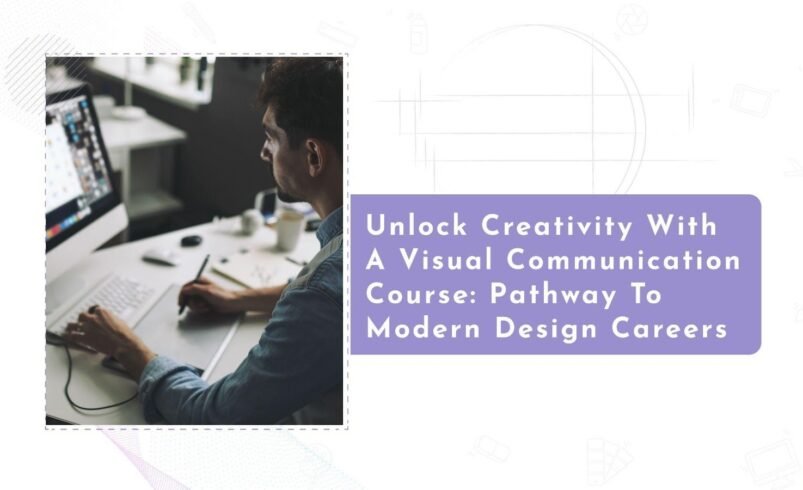A Complete Guide to Pursuing a Visual Communication Course

The Indian creative sector is developing very fast, and it makes the need to hire professionals who can integrate design, media and technology very high. In fact, the FICCI-EY Media and Entertainment Report 2024 projects that the industry will have exceeded INR 3 trillion by 2027. This growth is directly linked to the rising need for specialized academic programs such as the visual communication course.
This program is becoming more and more attractive to students all over India with its creative focus, digitally-focused innovativeness, and career-building opportunities. In contrast to traditional academic programs, a structured visual communication course includes practical skills, industry exposure, and international views, which makes it a rather appealing option to highly ambitious students.
Why Choose Visual Communication as a Career Path?
Opting for a visual communication course ensures both professional stability and creative satisfaction. In the digital-first world of the economy, companies and media outlets have flourished due to effective storytelling, multimedia, and branding, which visual communication practitioners can do best.
Key reasons for choosing this course include:
- Growing Industry Need: The industry is on a boom with over 1.2 million jobs in the creative industry to be seen in India by the year 2030.
- Global Applicability: Skills attained in a course of visual communication can be used across nations and even industries.
- Various Career Pathways: The course gives an opportunity the advertising, film, journalism, and digital content industries.
- Innovation and Technology: Students get to understand how to reconcile design principles and technical skills.
- Competitive Payments: PayScale 2024 indicates that creative workers receive between INR 4-9 LPA, with their salaries possibly increasing in the international markets.
This is the only course that offers a balance of creativity, employability and financial development, which makes a course in visual communication a smart career investment.
Key Highlights of a Visual Communication Course
A visual communication course structure is constructed in such a way that it gives holistic learning. The exposure exposes the students to both theory and real-life experiences, so that they are industry-ready on graduation. Key highlights include:
- Essentials of design: Typography, layout design, colour theory, and art history.
- Digital Media Training: Training in video production, photography and animation.
- Practical activities: Portfolio-based and real-world case studies.
- New Technologies: AR and VR training and interactive platform training.
- Collaborative Learning: Group projects that develop creativity and problem-solving within groups.
- Internship Opportunities: Industry tie-ups allow students to work on live projects with leading firms.
- Leverage in Career: The visual communication course equips participants with ways of creativity in various ways at the same time.
Such a multi-layered approach is important as it makes sure that students not only learn about the principles of design but also know how to use them in real life.
Skills You Develop During the Program
By taking a course in visual communication, the students are assisted in acquiring a combination of technical and creative skills that are in demand worldwide. These skills help the graduates to be dynamic in different industries and to adapt to the changing trends. Some key skillsets include:
- Creative Thinking: Thinking of new and creative ideas.
- Technical Mastery: Mastery of Photoshop, Illustrator, Premiere Pro, and other creative software.
- Storytelling Skill: creating effective visual storytelling for the media and branding.
- Analytical Research: Knowledge of audiences, the psychology of consumers and design trends.
- Communication Skills: Adequate teamwork and dealing with the clients.
- Flexibility: Have the ability to use creative skills in print, digital and interactive platforms.
- Problem-Solving: Approaching the issue of branding and communication challenges with original solutions.
The multifaceted skills will guarantee the holders of a visual communication course to be prepared to operate in a vibrant and changing creative scenery.
Career Opportunities after a Visual Communication Course
The visual communication course offers a wide variety of rewarding job opportunities. The industries that can be considered by graduates are advertising, marketing, journalism, digital media, and entertainment.
Popular career paths include:
- Graphic Designer: Developing logos, branding and digital layouts.
- Advertising Executive: Creation of effective product and service campaigns.
- Multimedia Artist: Deals with animation, 3D design and video graphics.
- Visual Journalist: A convergence of photography and design to make stories.
- UI/UX Designer: Creation of interactive and user-friendly digital experiences.
- Film and Video Editor: The creation and production of creative and polished visual content.
- Photographer: Specialising in commercial, fashion or event photography.
- Content Maker: The use of social media as a promotional tool.
According to NASSCOM reports, the digital creative jobs are expected to increase by 25 per cent per year in India. It is clear that a visual communication course not only enhances career opportunities but also gives graduates an international edge.
Why This University Stands Out for Visual Communication Studies
Choosing the right university for a visual communication course can make a major difference in career outcomes. An excellent institution goes beyond academic knowledge; it is an exposure to the real world, industry networking, and a site to innovate.
The following are some of the reasons why the right university is independent:
- Holistic Curriculum: Revised regularly to keep up with the international design and media trends.
- State-of-the-art Equipment: Studios, editing laboratories and computer aided design software.
- Expert Faculty: Professors with industry experience guide students effectively.
- Placement Assistance: Collaborations with advertising houses, movie houses, and media houses.
- International Cooperation: Cooperation and exchange programs across the world.
- Vibrant Alumni Network: Alumni in the best firms in India and beyond.
- Innovation-Based Strategy: The visual communication course will be designed to develop innovative problem-solving.
- Scholarships and Support: Financial aid makes it accessible to the meritorious students.
The benefits of having a visual communication course at the university level would include giving the students a solid academic base and competitive advantage in their careers.
Future Scope of Visual Communication in India
The relevance of a visual communication course will only grow as India embraces digitalization, creative branding, and multimedia platforms. The application of OTT platforms, online shopping, online advertising, and corporate branding is generating a steady need of visual communicators.
Competition among businesses in terms of consumer attention is making the skills of developing visually attractive and meaningful stories a critical one. This is where a graduate of a course in visual communication comes in-they provide knowledge that is creative and market relevant.
Conclusion
The creative economy in India is on an upward trajectory, and the need for skilled professionals is greater than ever. Pursuing a visual communication course allows students to step into a world where creativity meets technology, opening doors to advertising, journalism, multimedia, and beyond.
From learning design principles to gaining global exposure, the program equips graduates with the skills required to excel in fast-growing industries. With strong placement support, rising salaries, and wide-ranging career paths, a visual communication course is a gateway to success in the modern creative landscape.
Choosing the right university further enhances this journey, ensuring students are prepared for both academic excellence and professional achievement. For anyone passionate about design, media, and storytelling, this course is a stepping stone to a bright and fulfilling future.



